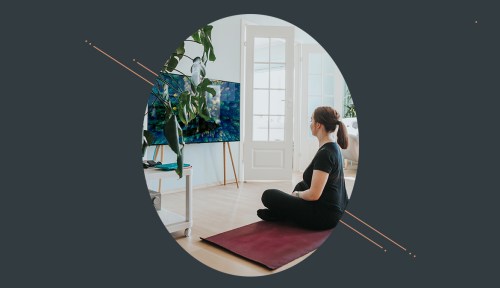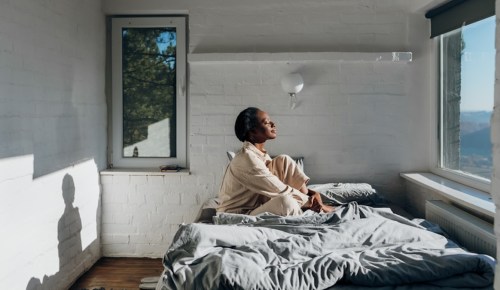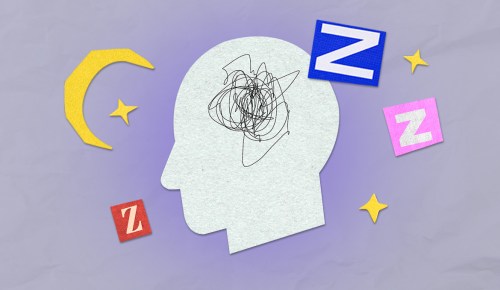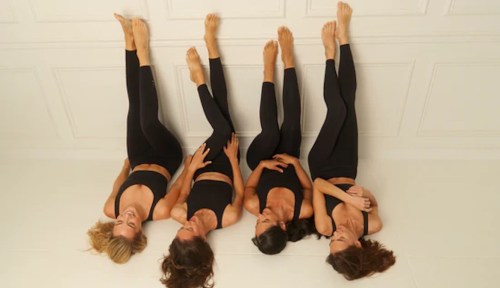Our editors independently select these products. Making a purchase through our links may earn Well+Good a commission
There’s no denying that a meditation practice can offer life-improving benefits. Research supports that the mindfulness technique can lead to feeling happier, being a more compassionate person, having lowered inflammation, and experiencing increased longevity. Colombian superstar J Balvin even credits meditation with saving his life. But for all of meditation’s benefits, it isn’t typically described as something that’s “fun.” If you were, for example, to tell a friend that your evening plans involved a night of meditating, they may give a smile, but chances are they won’t respond by saying, “Wow, how exciting!” or “Oh, you must be so pumped!” That may soon change, though.
Experts in This Article
Andy Puddicombe is a meditation and mindfulness expert. Prior to co-founding the meditation company Headspace, Puddicombe spent 10 years as a Buddhist monk.
Chris Advansun is the head of sleep stories at the meditation company Calm, working as a writer and producer that helps bring the sleep stories series to life.
Thubten Chodron is a Buddhist nun and meditation teacher. She has written several books, including Guided Buddhist Meditations.
In the past few years, the meditation industry has been securing its foothold at the intersection of the entertainment industry. In 2018, meditation app Calm launched an offshoot of its classic meditations called Sleep Stories, which consist of bedtime stories told by celebrities, including Harry Styles and Matthew McConaughey. The celebrity peg was so successful for drawing interest that Calm incorporated it into its meditation-based show, A World Of Calm, which premiered on HBO Max in October 2020 and enlisted more A-listers like Idris Elba and Nicole Kidman. Calm isn’t the only mindfulness giant getting in on streamed meditation shows: On January 1, mediation platform Headspace released its own Netflix series, Headspace Guide to Meditation.
The fact that these series appear on the streaming platforms alongside the likes of Schitt’s Creek and The Undoing illustrates meditation’s new overlap with entertainment, but a question remains: Can a person still reap the full benefits of meditation while being entertained?
Meditation on a small screen near you
Headspace Guide to Meditation spans eight episodes during which Headspace co-founder Andy Puddicombe—who previously spent 10 years living as a Buddhist monk in Asia, meditating up to 16 hours a day—teaches about the science and benefits of meditating. Each episode focuses on a different mindfulness technique, using animated characters and graphics to teach people how to be more present and mindful in their daily lives in a way that’s engaging and fun to watch.
“[Headspace] has always had a rich tradition of illustration and animation, and with the current climate and environment, it makes perfect sense to lean into that,” Puddicombe says. “There are a lot of people struggling with stress, anxiety, and sleep, and this is a way to give them the tool they need in an accessible way.” Puddicombe then ends every episode by leading a meditation.
“There are a lot of people struggling with stress, anxiety, and sleep, and this is a way to give them the tool they need in an accessible way.” — Andy Puddicombe, Headspace founder
Chris Advansun, head of Sleep Stories at Calm, says the company had a similar mission with releasing A World ofCalm during the pandemic. “It’s clear that 2020 has been a stressful year for us all. A World of Calm is our take on visual sleep content, at a time when folks need relaxation more than ever,” he says.
Though both series exist on entertainment-streaming platforms, meaning viewers must actively choose to watch them over the endless shows and movies popping up alongside them, Puddicombe says he doesn’t see Queer Eye or TheCrown as competitors. “We would never even pretend to compete with shows like that,” he says. “I see it more as a complement…maybe after bingeing Narcos, you may want a meditation,” he says with a laugh.
Still, the content on streaming platforms does have to be entertaining, or people will turn it off. And that’s where Puddicombe says the friendly illustrated animations come in. Advansun says World of Calm depends on the breathtaking landscapes it shows for a similar effect. “Each 22-minute episode takes audiences on an immersive visual journey into another world, and each relaxing tale is designed to transform how you feel,” he says. “Viewers will be transported into tranquility through carefully designed narratives, enchanting music, and gorgeous footage. These elements fuse together to create a calming, relaxing effect.” It’s not necessarily the grab-some-popcorn type of entertainment, but more so nature-porn escapism. And during a time when no one is traveling much of anywhere, there’s real value in that.
Can a meditation be entertaining while still honoring its cultural roots?
Given meditation’s deep cultural and religious roots that date back to approximately 1500 BC, I was curious if being entertained in the process was cheating, in a sense. According to Buddhist nun Thubten Chodron, who has authored many books about Buddhist meditation, including Guided Buddhist Meditations ($16), secular meditation can be entertaining without being problematic or appropriative.
“Traditionally, meditation’s role in Buddhism is a path to liberation,” Chodron says. “It’s looking at the meaning of life and how to be liberated from the cycle of rebirth. Meditation practice is supported by ethical conduct and compassionate actions in our daily life. It is not just what makes me feel good now. But as meditation has come to the West, some people have adapted its traditional techniques and use them as a way to relax and lower stress.”
To her, this secular meditation—which she says is different than Buddhist meditation in terms of intention, context, technique, and purpose—offers benefits and well-being, although it is not a path to enlightenment. Entertaining meditation can facilitate heightened relaxation and calm. But, she caveats that “entertaining meditation done with the purpose to relax and calm the body-mind is just that. It is not a spiritual path. Practicing a spiritual path entails changing our way of thinking and acting.”
“If you combine meditation with music and pretty images, or combine it with entertainment in other ways, it may not be a spiritual path to liberation, but it can still make you feel good and still be beneficial,” Chodron says. “If you’re being entertained in a way that makes you feel peaceful, that certainly can help with stress relief and feelings of calm, which are good things.”
Puddicombe says in the decade that he spent as a monk in Asia, entertainment and meditation coexisted. “In the monastery, we would have monks come visit and they weren’t celebrities within the world, but we knew who they were, and so they had a sense of celebrity to us,” he says. “They would tell stories that would inspire us and excite us.” In that sense, these special guest visits felt as exciting to them as a pre-bedtime story from Harry Styles may feel to the average pop-culture enthusiast. Furthermore, he adds, storytelling’s role in meditation has long made it entertaining; TV is just the latest medium to package the message.
The more places people can find guided meditations, the more likely they are to give it a try. Meditation apps have been living on our phones for years, and migrating over to our TVs just might make committing to a practice even more appealing. After all, phones can function as a vibrating and pinging beacon of stress where work emails, texts, and Slack messages live. But sitting on the couch in front of the TV has always been a place for relaxing. In that sense, meditation on TV is exactly where it belongs.
Oh hi! You look like someone who loves free workouts, discounts for cult-fave wellness brands, and exclusive Well+Good content. Sign up for Well+, our online community of wellness insiders, and unlock your rewards instantly.
Sign Up for Our Daily Newsletter
Get all the latest in wellness, trends, food, fitness, beauty, and more delivered right to your inbox.
Got it, you've been added to our email list.











